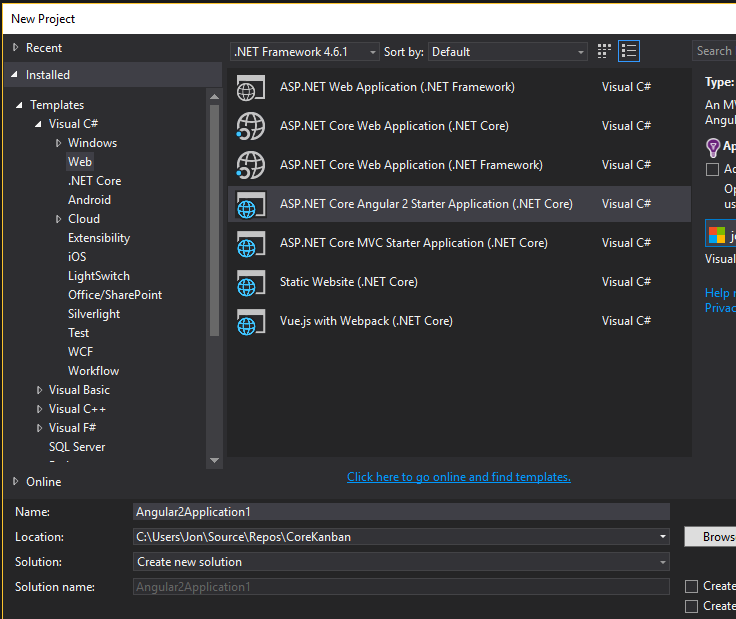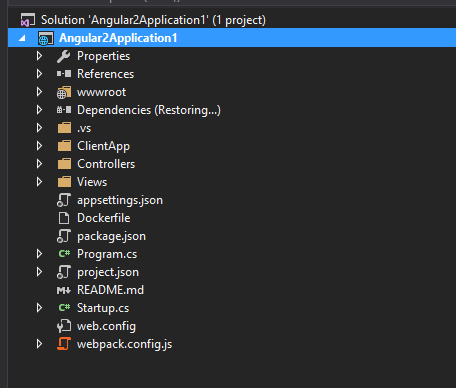Fast track your Angular 2 and .NET Core web app development
“If you’re an enterprise .NET developer who is used to a mature, integrated, rock-solid toolchain, HTML/CSS/JavaScript development will feel to you like a bag of cats. And the bag is on fire.“
‘badlife’ (Reddit)
Modern front-end development is a mess of competing frameworks, task runners and build systems that may just have you running back to the safety of ASP.NET and Visual Studio before you’ve even begun.
The slow road#
With Angular 1, you could take your existing ASP.NET web application, add a few script references and get on with adding some SPA goodness to your site.
Angular 2 changes all that, there is an entire ecosystem that you need to get up and running. You’ll be faced with setting up Grunt/Gulp or WebPack, NodeJS, Typescript and making it all work together before you can even think about writing “Hello World”.
Ignoring the obvious debate about the merits of this approach and whether all this complexity is really worth it (that’s a conversation for another day) you’re left wondering if there’s any way to test out Angular 2 and build something without learning every nuance of Node, WebPack or anything else deemed necessary by the Angular gods (AKA Google).
The highway#
Before you run screaming back to the (relative) safety of Visual Studio. Here’s another option.
Update – 21st February 2017
If you’re using Visual Studio 2017, check out an alternative way of creating your project using the dotnet new command.
If you’re using Visual Studio 2015 then you can take a shortcut by using the ASP.NET Core template pack. The pack includes a template for creating an Angular 2 with .NET Core project which will have you at “Hello World” in a few clicks.
That’s not to say you won’t need to learn all about WebPack and Node Modules at some point in the future, but you don’t need to derail your learning by getting all that set up from day one.
Make sure you have the following prerequisites installed.
Visual Studio 2015 Update 3 – Update 3 is required.
.NET Core Tooling Preview 2 or later (.NET Core Runtime 1.0.x and 1.1.0 are supported).
Then grab and install the templates.
Download the ASP.NET Core Template Pack.
For more detailed background information about the template pack (and a few gotchas you might run into), check out Steve Sanderson’s announcement post.
Hello World#
Phew, that’s still a lot of prerequisites and dependencies but now you can sit back, relax, and let the template set up your shiny new web application for you.
Open up Visual Studio and create a new project.
You should find some new templates available under “Web”.

Choose ASP.NET Core Angular 2 Starter Application (.NET Core) and fill out the usual details (name, location etc).
Once Visual Studio’s finished, you’ll see something like this.

Before we go into the details, hit CTRL-F5 to preview your app.

Made It#
So you did it, you got to Hello World without having to manually set up WebPack with Angular 2 and Typescript. But what can you do now?
In the next post we’ll explore the solution and add our first component.
photo credit: tudedude Arduino Controller For Mini Mill Stepper Motor via photopin (license)
All posts in Checking the weather with Angular 2 and ASP.NET Core
- Fast track your Angular 2 and .NET Core web app development
- Angular 2 and .NET Core – your first component
- Angular 2 and .NET Core – route directly to your components
- Display the weather using Angular 2 and .NET Core Web API
- Fetch the current weather using ASP.NET Core Web API and OpenWeather
- Send form input via an Angular 2 component to ASP.NET Core Web API
Struggling to figure out what to focus on with Blazor?
BlazorSharp - The .NET Web Developers community is here to help!
- Connect with your fellow .NET web developers
- Keep up to date with the latest .NET changes
- Exchange tips, tools and tactics